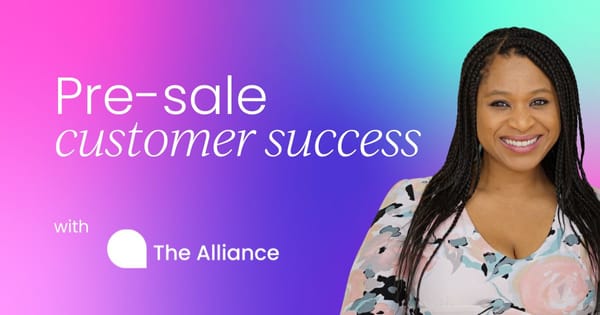Having worked in client services for the best part of a decade, I like to think I have a pretty good idea of what customer success is, and what it isn’t.
Even in name, customer success is wholly unambiguous about its one mission: To make customers successful; and to achieve their desired outcomes with the product or service they’ve bought. This ethos should perforate every corner of an organization: From product, to marketing to sales.
But more often than not, the goals of customer success are siloed to its representative department or team. This can be a head-scratcher for many reasons. After all, isn’t having successful, loyal customers who repeat purchases the crux of every business?
In this article, I’ll be discussing how customer success can be incorporated before the point of purchase, to maximize customer lifetime value, customer experience, and establish foundations for revenue growth.
We’ll specifically be looking at:
- Why customer success should be introduced pre-sales
- How you can best collaborate with sales, marketing, and product
Why customer success should be introduced pre-sale
More often than not, customer success is siloed as a post-sales function. This begs the question: How can customer success – and CS activities – integrate into all the different departments?
Viewing customer success as a post-sales function has its limitations. For example, let’s take the traditional model of customer success: You onboard your customers; you try to get your customers to engage with your product; you monitor that engagement; and you identify areas for their account to grow.
There’s nothing wrong with this model at all. Customer success does these activities, no doubt about that. In fact, it's the baseline of all successful customer success functions. But what if you could take it further?
What if we get brought in before the sale is made. What does customer success look like pre-sales? Does it work? Can it work? (The answer is “yes” to both questions, FYI!)
How to incorporate customer success before a sale
The customer success community is full of incredible champions of the CS cause, helping demonstrate why a value-led, outcomes-based approach to customer relationship management should be every organization’s number one priority.
You can take this one step further and argue that customer success should be a company-wide philosophy, and not just something that can be conveniently organized into one post-sales department, into one team.
To bring customer success in pre-sale requires organizational buy-in; your CEO and the rest of the C-suite need to believe in the CS mission wholeheartedly. To truly iterate the mission of customer success, you want to introduce it as soon as possible.
Think of customer success as a selling point for your organization. It’s a proactive, white-glove treatment that showcases how willing your organization is to the client’s success. Bringing customer success in on a discovery call with your salesperson offers a wealth of additional possibilities.
Being introduced to the client before the sale has taken place (while they’re still a prospect) gives CS a chance to hit several key targets all in one fell swoop. If your sales team is on the fence about you joining their discovery call, remind them that this meeting provides a unique opportunity to:
- Consult with your sales team to provide expertise
- Assess the prospect’s needs thoroughly
- Share relevant examples from other client solutions
- Support sales process with expert product knowledge
Think like a salesperson
For those of us who’ve been in the customer success game a long time, back when it was more-or-less account management, we tend to say we're undercover salespeople. I know CS purists may come for me for saying that, but it’s true! Customer success professionals understand the importance of nurturing accounts for expansion.
Hear me out: While we're not the ones chasing down the deal, we should still be sowing the seeds of account expansion in the client’s mind. And a lot of this comes down to access. Being able to have access to prospects early means that customer success can add that additional value.
Salespeople can speak to product capabilities and reference client success stories. However, the customer success team's proximity to real-world usage situations positions them to provide richer context around processes.
By participating in discovery calls, customer success can draw directly from client feedback to confidently articulate specifics that resonate with prospects. This granularity stems from their behind-the-scenes understanding that comes from working closely with the product and portfolio of accounts.
But even if CS isn’t on the discovery call, you can still involve customer success early on in the process. Early access to prospects facilitates communicating actual client feedback and explaining processes in granular detail. With enough time to prepare, customer success can proactively create customized materials for prospects.
Cross-departmental collaboration
Customer success and sales
To me, the tag-teaming aspect of this process – bringing together sales and customer success – combines both team's strengths for mutual benefit. Customer success provides insight into client needs which helps in contextualizing product value.
Sales directly engage prospects while keeping customer success apprised for crafting tailored solutions. This symbiotic relationship epitomizes why breaking down departmental silos unlocks an organization’s full potential in ensuring customer outcomes and experiences.
When brought into the customer journey early on larger accounts, my top priority has always been understanding what clients hope to achieve with our product. Participating in these initial discussions provides invaluable insight into the type and level of support that will be needed down the road. With prospects clearly conveying their goals upfront, customer success can conduct an early needs assessment of sorts.
In a prior role, I leveraged some excellent customer personas developed by marketing to anticipate the care larger prospects would require. I effectively utilized these five personas as a complementary sales tool to the vital efforts of account executives.
As the sales team conducted discovery calls, I’d schedule follow-up consultations and put together a deck summarizing skill gaps needing attention, strategic recommendations based on the personas, and ideal next steps.
Of course, I aligned these plans with our Head of Sales regarding the products they wanted to position. My objective was to provide additional expertise that advanced conversations and ensured prospects fully grasped solutions tailored to their needs.
If you want to have a customer-centric organization, one in which CS really is everybody's responsibility, then bringing in customer success early is essential.
Customer success and marketing
In the past, I’ve collaborated closely with our marketing team to produce in-depth case studies of successful client implementations. We spotlight specific customers and document the business outcomes they achieved using our product. These studies illustrate the tangible ROI, increased efficiency, higher production, or other metrics real clients experience.
Beyond individual case studies, we work together to identify broader trends across our current and target audiences based on particularly effective product usage behaviors and strategies we observe. These may relate to different client segments or use cases. Marketing is then able to take these real-world customer insights and convey the proven success new users can expect by working with us.
The case studies and trends provide concrete proof points marketing leverages across advertising, the website, sales collateral, and events. They turn the data and patterns we provide into compelling evidence of achievable results. This content directly answers prospect questions about what their experience may look like. The authenticity and transparency stem from marketing and customer success collaborating to highlight real customer journeys.
Customer success and product
You can’t talk about cross-departmental collaboration without featuring the key team: product development. Product development actively works with customer success to understand voice-of-customer-driven needs to enhance the product.
Our collaboration also pinpoints where we’re lacking with our current offerings, as well as potential gaps in the broader market, enabling us to develop innovative new products.
With constant user contact, CS teams offer an unparalleled understanding of pain points and feature needs. This proximity uniquely qualifies them to collect qualitative and quantitative feedback that truly represents the voice of the customer.
In particular, CS should funnel inputs from diverse channels into a unified repository. By logging detailed customer requests, questions around pricing, struggles with workflow, and more, a clear picture of product weaknesses emerges. In fact, these insights can pave the way for an entirely new product, or a whole suite of products if the demand is there.
Customer success has a certain context around use cases and workflows, which help accurately diagnose where functionality falls short of user needs. Armed with this granular customer data, the product team can implement targeted improvements that address friction points and shortcomings.
Loop closures from CS reinforce that user voices shape progress, increasing retention and revenue. Involving CS pre-sale puts your finger on the pulse so you can build an optimal product before issues arise and customers churn.
For example, in a previous role, I took an unused framework that I adapted to be used as a consultative tool for conducting needs-based analysis for prospective clients during the nurturing phase of the sales cycle. This helped identify client-specific gaps that we were able to link to our other products and later was used to create a brand-new product in and of itself.
But it all started off as a customer-success-specific tool to use in early sales calls as a direct response to gathered client feedback. That’s the beauty of collaboration. Customer success was sitting on a resource that was gold dust to our product (and marketing) team, and had we not pooled together, then we wouldn’t have expanded our product offerings to cater to the ever-changing new customer needs.
Parting thoughts
Essentially, customer success should integrate itself across all departments by positioning our unique proximity to customers. That’s our hallmark. That’s what makes our insights so unique. The insights we gather from direct feedback, experiences, and identified client needs are invaluable sources of knowledge other teams can't access day-to-day.
We inject these learnings into other disciplines so outcomes across the board become more customer-centric. It moves beyond just sales pitching persuasively. CSMs can tap into the customer segments we’ve defined to deeply understand our prospects and determine what will resonate.
By having customer success directly join calls, sales, marketing, product, and community interactions all become enriched by our on-the-ground expertise. For the businesses I’ve worked for, having that embedded, integrated approach is wholly distinctive.
Have we piqued your interest in customer success leadership?
If our exploration of customer success leadership has stirred a desire to take your expertise to the next level, we have the perfect opportunity.
Enroll in our Customer Success Leadership program and become a champion of driving customer success while propelling business growth.
What to expect from this game-changing course:
🧠 Continuous, actionable leadership insights from industry pioneers
🔧 Practical leadership strategies and tactics to implement
📚 Hands-on activities and real-world case studies
💡 An endless stream of fresh ideas and diverse perspectives
🔥 Transform your leadership style
🧱 Build a strong personal brand with guidance



 Follow us on LinkedIn
Follow us on LinkedIn








